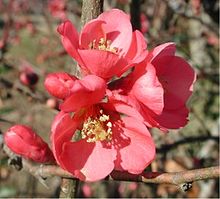Chaenomeles
| Chaenomeles | |
|---|---|
 |
|
| Chaenomeles in flower, probably a cultivar of C. × superba | |
| Scientific classification | |
| Kingdom: | Plantae |
| (unranked): | Angiosperms |
| (unranked): | Eudicots |
| (unranked): | Rosids |
| Order: | Rosales |
| Family: | Rosaceae |
| Subfamily: | Amygdaloideae |
| Tribe: | Maleae |
| Subtribe: | Malinae |
| Genus: |
Chaenomeles Lindl. |
| Species | |
|
Chaenomeles cathayensis |
|
Chaenomeles cathayensis
Chaenomeles japonica
Chaenomeles speciosa
Chaenomeles is a genus of three species of deciduous spiny shrubs, usually 1–3 m tall, in the family Rosaceae. They are native to Japan, Korea, China, Bhutan, and Burma. (Burmese: ချဉ်စော်ကား) These plants are related to the quince (Cydonia oblonga) and the Chinese quince (Pseudocydonia sinensis), differing in the serrated leaves that lack fuzz, and in the flowers, borne in clusters, having deciduous sepals and styles that are connate at the base.
The leaves are alternately arranged, simple, and have a serrated margin. The flowers are 3–4.5 cm diameter, with five petals, and are usually bright orange-red, but can be white or pink; flowering is in late winter or early spring. The fruit is a pome with five carpels; it ripens in late autumn.
Chaenomeles is used as a food plant by the larvae of some Lepidoptera species including Brown-tail and the leaf-miner Bucculatrix pomifoliella.
Although all quince species have flowers, gardeners in the West often refer to these species as "flowering quince", since Chaenomeles are grown ornamentally for their flowers, not for their fruits. These plants have also been called "Japanese quince", and the name "japonica" (referring to C. japonica) was widely used for these plants in the 19th and 20th centuries, although this common name is not particularly distinctive, since japonica is a specific epithet shared by many other plants. The names "japonica" or "Japanese quince" were (and still are) often loosely applied to Chaenomeles in general, regardless of their species. The most commonly cultivated Chaenomeles referred to as "japonica" are actually the hybrid C. × superba and C. speciosa; C. japonica itself is not as commonly grown.
...
Wikipedia
